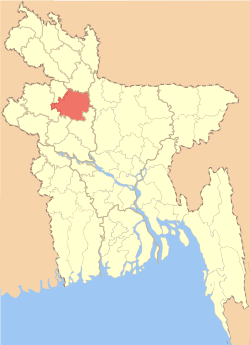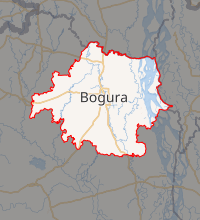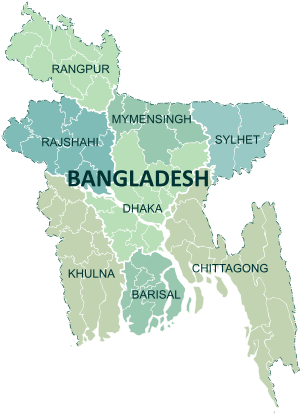Bogra District
Bogra District, officially known as Bogura District,[1] is a northern district of Bangladesh, in the Rajshahi Division.[2] It is called the gateway to North Bengal. Bogra is an industrial city where many small and mid-sized industries are sited. Bogra district was a part of the ancient Pundravardhana territory and the ruins of Mahasthangarh, the ancient capital of Pundravardhana, are located north of Bogra.
Bogra District বগুড়া জেলা | |
|---|---|
| Bogura District | |
Ramparts of Mahasthangarh citadel in Bogra | |
 Location of Bogra District in Bangladesh | |

Expandable map of Bogra District | |
| Coordinates: 24.78°N 89.35°E | |
| Country | |
| Division | Rajshahi Division |
| Pundravardhana | 1280 BC |
| Area | |
| • Total | 2,898.68 km2 (1,119.19 sq mi) |
| Population (2011 census) | |
| • Total | 3,400,874 |
| • Density | 1,200/km2 (3,000/sq mi) |
| Literacy rate | |
| • Total | 68.4% |
| Time zone | UTC+06:00 (BST) |
| Postal code | 5800 |
History
Ancient history
Bogra District occupies an important place in the legendary and the earlier historical annals of Bengal. In the ancient period, it was a part of the territory of the Pundras or Paundras, which was known by the name of Pundravardhana. Pundravardhana was one of the kingdoms of Eastern India and was separated by the stream of Karatoya from the more easterly kingdom of Prag-Jyotisha or Kamrupa. The name, Pundravardhana, occurs frequently in the Mahabharata, Ramayana and the various Puranas. According to the Mahabharata and the Puranas, Vasudeva, a powerful prince of the Pundra family, is said to have ruled over Pundravardhana as far back as 1280 BC. The claims of the district to antiquity, however, rests chiefly on association which centre round the old fortified town, now known as Mahasthangarh.[3]
This district was under the following rules:
The Mauryas (4th century to 3rd century B.C.)
This district was under the rule of the Mauryas in the 4th century BC. This is evident from the existence of some Pillars of Ashoka in many parts of Pundravardhana and from the discovery of an old Brahmi Inscription at Mahasthangarh in this district. Bhadra Bahu, a high monk of the Jain religion and a son of a Brahmin of Kotivarsha in Pundravardhana, was the Jain-Guru of Chandra Gupta Maurya. As Ashoka was a firm believer in Buddhism, he put to death many naked Sectarians (presumably the Jains in Pundravardhana.[3]
The Guptas (3rd century AD to the 5th century AD)
The Gupta authority over this district is revealed from the discovery of a number of inscriptions of that period from Pundravardhana. Pundravardhana was a Bhukti under the rule of Guptas till the end of the 5th century.[3]
Sasanka (the first quarter of the 7th century AD)
By the beginning of the 6th century this region might have passed under the rule of the Gaudas of Bengal. But the history of a century of this district lies in obscurity. However, at the beginning of the 7th century. Sasanka came upon the throne of Gauda and he definitely exercised his authority over Pundravardhana (including this district).[4]
Harshavardhana (the second quarter of the 7th century)
This region must have passed after death of Sasanka under the rule of Harshavardhana (606–647). This evident from the account of the Chinese pilgrim Xuanzang who visited Pundravardhana probably in 640 AD.[4]
The Palas (c. 750–1150)
By the middle of the 8th century (c. 750) one Gopal assumed control of the affairs over North Bengal, established a royal dynasty known as the Pala Dynasty. After Gopal was elected king, he took his seat in Pundravardhana. He ruled over the region up to c. 780 and was succeeded by his son Dharmapala (c. 781–821). The Pala Kings had peaceful possession of this district up to the end of their rule over Bengal which ended in the 12th century. Dharmapala was the son and the successor of Gopala, extended his power beyond Pundravardhana. Like his father he was a Buddhist and founded the famous Buddhist Vihara at Somapuri in Varendra, the ruins of which have been discovered in the Naogaon District.[4]
The Senas (c. 1150–1204)
The Senas originally came from the Deccan and settled in West Bengal. Vijayasena was the first great ruler of the dynasty. He defeated the last Pala king Madanapala, and established his authority over this district. He was succeeded by his son, Vallalsena (1160–1178) who was in definite possession of the district. He built his capital at Bhabanipur (a shakti-peeth) in this district. Lakshmanasena (1178–1204), the son and successor of Vallal Sena, exercised authority over this district till he was driven out by Ikhtiyaruddin Muhammad-bin-Bakhtiyar Khalji in 1204. Even after this date, a dynasty of Sena Rajas ruled for nearly a century over the north-eastern tract of this district as feudatory chiefs under the suzerainty of the Muslim rulers of Bengal. Their capital was at Kamalpur, a few miles to the north of Bhabanipur (a site of pilgrimage for the Hindu devotees) and a little to the south of Sherpur. Achyuta Sena was the last Prince of the line.[5]
British Era
The present Bogra District was first formed in 1821 during British rule. In the 1901 census, the population of the district (on a reduced area) was around 854,533, an increase of 11% in the decade, the census revealed there was no town with as many as 10,000 inhabitants.[6] The famous Prafulla Chaki(1888–1908) was born in this district.
Battle of Bogra and recent history
The area was enveloped in thick fighting in the Battle of Bogra between the allied troops of Mukti Bahini and Indian Army (combined) which defeated the Pakistan Army during the Bangladesh Liberation War of 1971.
In 2018, the Government of Bangladesh changed its spelling of the name of the district from Bogra to Bogura.[7]
Geography and climate
Formation of land
| Karatoa River | |
|---|---|
Karatoa River near Mahasthangarh | |
 | |
| Location | |
| Country | Bangladesh |
| Region | Rajshahi Division |
| City | Bogra |
The area consisting whole of Upazila Sariakandi, Gabtali, Sonatala and major part Dhunat is called the eastern alluvial tract. Fertilized by the silt of flood waters, the eastern alluvion is one of the most fertile and prosperous areas in Bogra, Jute, aus, aman paddy, sugarcane and pulses are grown. Sometimes as many as three or more crops are grown on one field in a year without any apparent diminution of its productivity.[8]
The western portion of the district is a marked contrast to the eastern one. In most parts it is well-wooded. Dense shrub jungle is to be found is Upazilas of Sherpur and in parts of Sibganj, which has a comparatively large proportion of cultivable waste land. This part of the district is slightly higher than the eastern parts and is generally above flood level. The soil of this part is generally suited to the growth paddy. Adamdighi is well known for the fine qualities of rice. This rice is grown some extent in the Shibganj Upazila. [8]
The tract to the east of the Karatoya is a part of the valley of the Brahmaputra and is generally low-lying and intersected by numerous khals (Canals) and shallow swamps and marshes. It is subject to yearly inundation from the overflow of the Brahmaputra and, therefore, gets a rich deposit of silt. There is very little jungle and almost the entire area is under cultivation.
Rivers
There are quite a few rivers in the Bogra District. The Karatoya is the central divider of water-channel of the district, the other rivers may be classified into the eastern and western systems.[9] The names of the some important rivers of this district are as follows:
- The Bangali
- The Karatoya
- The Jamuna
- The Nagar
- The Tulshiganga
Climate
The district has a humid subtropical climate.
| Climate data for Bogra | |||||||||||||
|---|---|---|---|---|---|---|---|---|---|---|---|---|---|
| Month | Jan | Feb | Mar | Apr | May | Jun | Jul | Aug | Sep | Oct | Nov | Dec | Year |
| Average high °C (°F) | 23.0 (73.4) |
27.3 (81.1) |
32.6 (90.7) |
35.1 (95.2) |
33.5 (92.3) |
32.0 (89.6) |
31.4 (88.5) |
31.4 (88.5) |
31.5 (88.7) |
31.0 (87.8) |
28.9 (84.0) |
25.5 (77.9) |
30.3 (86.5) |
| Daily mean °C (°F) | 16.4 (61.5) |
20.0 (68.0) |
25.2 (77.4) |
28.8 (83.8) |
28.8 (83.8) |
28.7 (83.7) |
28.7 (83.7) |
28.7 (83.7) |
28.5 (83.3) |
27.1 (80.8) |
23.2 (73.8) |
19.0 (66.2) |
25.3 (77.5) |
| Average low °C (°F) | 9.8 (49.6) |
12.7 (54.9) |
17.9 (64.2) |
22.5 (72.5) |
24.1 (75.4) |
25.5 (77.9) |
26.1 (79.0) |
26.1 (79.0) |
25.6 (78.1) |
23.2 (73.8) |
17.6 (63.7) |
12.6 (54.7) |
20.3 (68.6) |
| Average precipitation mm (inches) | 9 (0.4) |
13 (0.5) |
21 (0.8) |
61 (2.4) |
210 (8.3) |
326 (12.8) |
396 (15.6) |
303 (11.9) |
257 (10.1) |
145 (5.7) |
15 (0.6) |
6 (0.2) |
1,762 (69.3) |
| Average relative humidity (%) | 44 | 34 | 36 | 45 | 63 | 74 | 74 | 74 | 72 | 68 | 50 | 46 | 57 |
| Source: National newspapers | |||||||||||||
Industry
Bogra was once the industrial capital of Bangladesh. There were several heavy industries. Most of them were owned by the local elite families "Jamil", "Bhandari", "Tajima", and "Khalifa". Various industries of "Tajma" were also a name among the rich and famous. Bhandari's had several establishments. Among them, Bogra Cotton Spinning Mills, North Bengal Tannery, Habib Match Factory, Golam Kibria Soap Works, Bhandari Glass works, Bhandari Biri were the prime ones. In the other hand, Jamils are keeping their business like Jamil Housing, Jamil shopping complex, Jan-e-saba community centre and others. Tajma still leads their position, Mr. Amjad Hossain Tajma, managing director of the Tajma group of Industry heading their business named Tajma Creamic Industry, Tajma Enamel Industry, Transfer Paper Limited, Agrofresh Limited, Snowbe Ice Cream Industry and so on.
Local language (dialect of Bogra)
The mother tongue of this district is Bengali. In this district of Bogra "the dialect spoken is what is known as Northern dialect of Bengali of the Eastern Branch," says Dr. Grierson, may be taken to be the form of the language, which is spoken in the Dinajpur District, but the form of the dialect spoke in Bogra differs very little from that of Dinajpur. The northern dialect is spoken in the district of Rajshahi, Dinajpur, Rangpur, Bogra and Pabna. The whole of the tract has within historic times been subject to Koch tribes and members of this tribe still exist in each district. They were originally reported as speaking their original Koch language, but on an examination of the specimens of the language, Dr. Grierson found that they have given up their original speech, and now only speak more or less corrupt variety of Northern Bengali.[10] Some peculiarities (examples) are given below (Bengali>Dialect, English).[11]
- Initial a in the first person becomes ha, e.g. ami>hami, I ; amar>hamar, my; amra>hamra, we; amak>hamak, me; etc.
- Aspirated sound becomes unaspirated e.g. chokh>chok, eye; gachh>gach, tree; Jachchhi>Jachi, going; etc.
- In vocative case go, have ba reba are used, e.g. kya ra ba? jabuna?, hello! Will you not go. In feminine gender ro is used in place of ra e.g. Kyaro! Ki Kortitachu? Hello! What are you doing?
- U is used as final vowel in verb e.g. Jabi>Jabu? Will you go? Khachchhish??Khachchu?, Are you eating?; etc.
Religion
The district of Bogra consists 3472 mosques, 686 temples, 37 churches and 58 tombs.
Culture
Folk literature
Marefati, dehatatwa, dhua, meyeli gan and other types of folk songs and also Prabad, Prabachan, folk-tales etc. are in use among the people of the Bogra District.
Administration
- Administrator of Zila Porishod: Mokbul Hossain[12]
- Deputy Commissioner (DC): Nur-E Alam Siddique
Upazilas
Bogra has 12 Subdistricts (Upazilas):
Education
- Pundra University of Science & Technology
- Bogra Zilla School
- Bogra Cantonment Public School and College
- Bogra Polytechnic Institute
- Government Azizul Haque College
- Government Mustafabia Alia Madrasha
- Shaheed Ziaur Rahman Medical College
- Bogra Govt. College
- Govt. Shah-Sultan College
- Bogra Govt. Mujibur Rahman Mahila College
- Kahaloo University College
- Bogra Govt. Girls' High School
- Bogra Armed Police Battalion Public School And college
- Police Lines School and College, Bogra
Notable residents
- Prafulla Chaki (1888–1908), revolutionary and nationalist, was born in Bihar village.[13]
- Mohammad Ali Bogra (1909–1963), former prime minister of Pakistan, was elected to the legislature from Bogra.[14]
- M. R. Akhtar Mukul (1929–2004), author and journalist, migrated to Mahasthangarh after the Partition in 1947.[15]
- Ziaur Rahman (1936–1981), President of Bangladesh (1977–1981), spent part of his childhood in Bagbari village.[16]
- Begum Khaleda Zia (born 1945), former prime minister of Bangladesh, was elected to parliament from Bogra.[17]
- Mafiz Ali Chowdhury (1919-1994) former Member of Parliament and government minister.
- Tarun Majumdar Bengali Indian Film Director
See also
- Majhira Cantonment
- Districts of Bangladesh
References
- Mahadi Al Hasnat (2 April 2018). "Mixed reactions as govt changes English spellings of 5 district names". Dhaka Tribune. Retrieved 8 April 2018.
- Md Nazmul Haq (2012). "Bogra District". In Sirajul Islam and Ahmed A. Jamal (ed.). Banglapedia: National Encyclopedia of Bangladesh (Second ed.). Asiatic Society of Bangladesh.
- Bangladesh District Gazetteers:Bogra. Government of Bangladesh. 1979, pp. 27
- Bangladesh District Gazetteers:Bogra. Government of Bangladesh. 1979, pp. 27–28
- Bangladesh District Gazetteers:Bogra. Government of Bangladesh. 1979, p. 28
- Bogra – Encyclopædia Britannica article
- "English spelling of five districts changed". New Age. Dhaka. 2 April 2018. Retrieved 3 April 2018.
- Bangladesh District Gazetteers:Bogra. Government of Bangladesh. 1979, p. 81
- Bangladesh District Gazetteers:Bogra. Government of Bangladesh. 1979, pp. 2–8
- Bangladesh District Gazetteers:Bogra. Government of Bangladesh. 1979, pp. 217–219
- Bangladesh District Gazetteers:Bogra. Government of Bangladesh. 1979, pp. 219–220
- "AL men appointed administrators". The Daily Star. 15 December 2011. Retrieved 7 April 2016.
- Md. Muktadir Arif Mozammel (2012). "Chaki, Prafulla". In Sirajul Islam and Ahmed A. Jamal (ed.). Banglapedia: National Encyclopedia of Bangladesh (Second ed.). Asiatic Society of Bangladesh.
- Ali, Syed Hamde (20 October 2009). "Mohammed Ali of Bogra". The Daily Star. Retrieved 1 April 2015.
- "Bangladesh: MR Akhtar Mukul passes away". The Daily Star (Bangladesh). 27 June 2004. Archived from the original on 7 March 2012. Retrieved 20 November 2010.
- Emajuddin, Ahamed (2012). "Rahman, Shahid Ziaur". In Islam, Sirajul; Jamal, Ahmed A. (eds.). Banglapedia: National Encyclopedia of Bangladesh (Second ed.). Asiatic Society of Bangladesh.
- "Parliament Election Result of 1991,1996,2001 Bangladesh Election Information and Statistics". Vote Monitor Networks. Archived from the original on 28 December 2008. Retrieved 1 April 2015.
| Wikimedia Commons has media related to Bogura District. |
